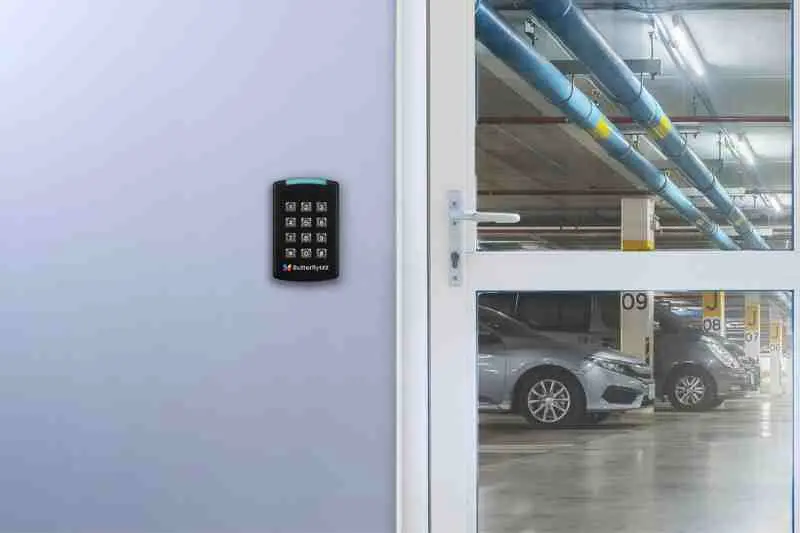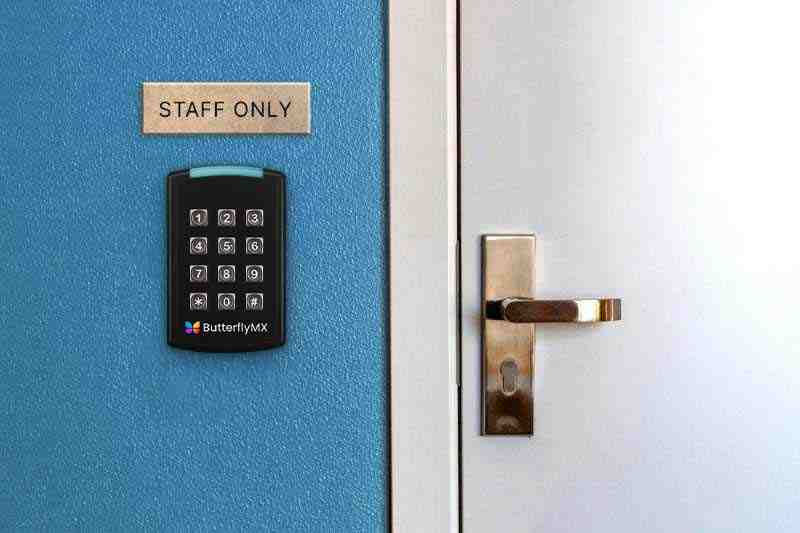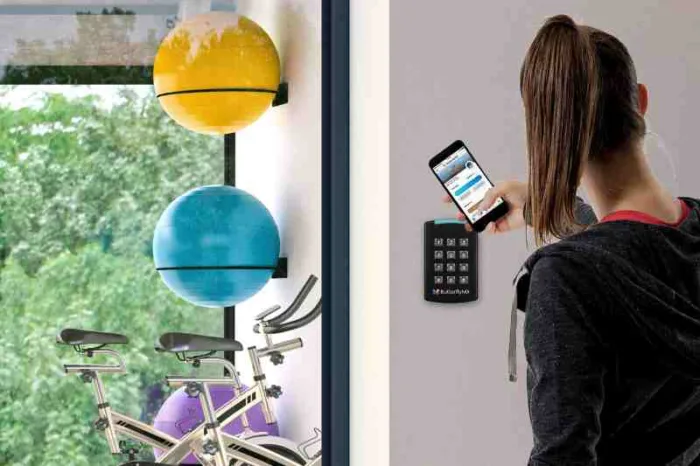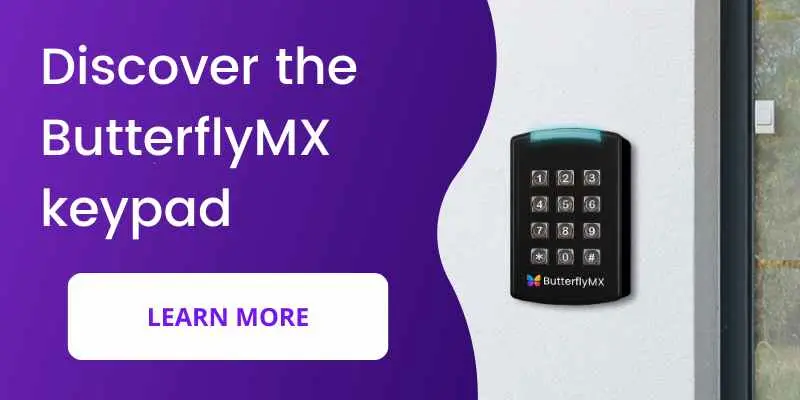Key takeaways
- Keypad door entry systems are a powerful, versatile access control solution — especially if you choose smart keypads with a mobile app and cloud-based software.
- While you may not want to install a keypad door entry system at your front door or gate, they’re an ideal solution for auxiliary entrances, garages, amenity rooms, and other shared spaces.

If you’re looking for a way to control access throughout your property, remember that security is only one of many factors to consider. What’s more, you want to ensure access is simple and convenient for residents and their guests. So, one access control device you might consider is a keypad door entry system.
In this post, we explore the best keypad door entry systems. Then, we cover what a keypad entry system is and how it works. Finally, we go over the best features to look for in a keyless system.
This post covers:
- 3 best keypad door entry systems
- What is a keypad door entry system?
- How much does keypad entry cost?
- How to use a keypad door entry system
- Choosing the best keypad door entry system
3 best keypad door entry systems
Looking for the best commercial keypad entry system for your property?
Here are our picks of the best keypad door entry systems:
1. ButterflyMX
With over 10,000 installations in multifamily and commercial properties and over 20,000 five-star reviews, ButterflyMX offers the best keypad for all industries.
Here’s what sets ButterflyMX apart:
- Achieve seamless access anywhere. Control and manage access to any door, garage, or shared amenity space remotely. What’s more, you can customize and manage who can access certain spaces and when.
- Multiple ways to unlock. Unlock any access point using the swipe-to-open feature on a smartphone or with a PIN code.
- Keep track of all entry events. For enhanced security, easily accessible time- and date-stamped audit logs make it convenient to see who uses the lock.
- Easily change access permissions. For added flexibility, access permissions can be modified or revoked at any time. What’s more, you can customize these access permissions remotely with a mobile app or through an online portal.
- Visitor Passes. Share temporary Visitor Passes with guests, service providers, and delivery couriers for seamless and secure access.
- Simple to install. Because the ButterflyMX keypad is cloud-based, it’s simple to install, requiring limited wiring, and in some cases, utilizing your property’s existing wiring.
- Complete property-wide access. The cloud-based ButterflyMX keypad integrates with a suite of unified access control solutions for a cohesive end-to-end experience.

2. Yale Assure 2 WF1 Deadbolt
Want convenient, keyless entry to your home, rental, or apartment building? Yale offers secure, smart keypads for your peace of mind.
The Yale keypad for doors offers valuable features like:
- Multiple ways to open. With a Yale Assure Lock, you can easily open doors with a PIN code or smartphone.
- Grant access to guests. Temporary Visitor Passes grant access to visitors quickly and easily.
- WiFi-powered. Because a Yale Assure Lock connects directly to WiFi, you don’t need a hub or additional plug-in.
- Auto-locking. Because this model auto-relocks after use, unauthorized visitors won’t be able to follow someone with a valid credential into the building.
- Extended battery life. The batteries have a 12-month battery life. So you won’t have to worry about constantly replacing them.
- Convenient integrations. The Yale keypad lock set is compatible with ButterflyMX — making seamless access easier than ever.
3. Dormakaba EVO LZ series
Offering comprehensive, cloud-based solutions, Dormakaba provides a variety of keyless systems for airports, apartments, healthcare facilities, and more.
The Dormakaba residential keypad door lock offers:
- Several ways to open. With Dormakaba, you can open your door with a smartphone, PIN code, or RFID credential.
- Real-time notifications. Always stay in the know of who’s accessing your property with real-time notifications of all entry events.
- Tamper-proof design. Because this lock is tamper-proof, it enhances security by deterring potential vandals.
- Stores up to 2000 credentials. Dormakaba keypad locks are great for large-scale buildings and can store any mix of RFID, PIN, or mobile credentials. What’s more, it stores up to 5000 entry events.
- Seamless integrations. Integrates with property management systems like ButterflyMX for a completely unified experience.
What is a keypad door entry system?
A keypad door entry system is a keyless access control solution that allows users to unlock doors using PIN codes. For this reason, these systems are a popular way to manage access to a building or room without handing out keys.
Some keypad access control systems can only be programmed to accept one PIN code credential. In other words, all tenants share and use the same PIN to gain access. In contrast, other keypad entry systems allow each tenant to set their own personal PIN code.
Keypads secure all kinds of spaces, from gyms to co-working spaces to rooftops in multifamily and commercial properties. You can use keypads to control access to doors in interior and exterior spaces. However, if you want to install an outdoor keypad, you should ensure it’s IP65-rated to withstand weather conditions.
Keypad door entry systems have three components:
- Keypad. The keypad device is installed on or near the door it secures. Some keypads have a camera that takes a picture of every door entry event, creating a secure audit trail that staff can review.
- Software. Beyond just the keypad device itself, you also need a way to store all the system’s data, which includes tenant information and all the authorized PIN codes. Keypad systems store data either in an on-site server or in the cloud.
- Electric or magnetic lock. While the keypad accepts credentials and the system’s software verifies a resident’s identity, it’s the electric lock that actually moves to let a resident in. Whether a lock is electric or magnetic, it needs to detect electric currents so that it can unlock when the system sends a signal.
Watch how to use the ButterflyMX keypad:
How much does keypad entry cost?
While the cost of keypad systems varies, most commercial keyless entry systems cost between $500 and $1,500 per door. For this reason, keypad entry systems are ideal for high-traffic environments like building entrances, garages, amenity spaces, and more.
How to use a keypad door entry system
For tenants, using a keypad is simple and convenient. Keyless door entry systems, like keypads, allow residents to gain property access without the fear of misplacing a small, easily lost credential.
Here’s how a resident uses a door keypad entry system:
- Enter a PIN number. The keypad may have a touchscreen or mechanical buttons for tenants to enter their PIN code.
- Keypad unlocks door. When the keypad receives the correct PIN, it unlocks the door by sending an electric current to the lock. Then, when the lock disengages, the resident can enter.

Managing a front door keypad entry system
If your building has a keypad entry system, staff must be able to add and remove users from the system, update access permissions, and set times during which the keypad can be unlocked.
Generally speaking, there are two types of keypad systems: analog and cloud-based keypads. Cloud-based systems are much easier to manage and update than analog keypads.
Analog vs. cloud-based keypads
Managing analog keypads requires time-consuming manual work. If you want to add a PIN number or remove a user from the system, you’ll have to go on-site and make those changes within the keypad. In some cases, you may have to punch in a ‘command number’ to change settings. And if you enter the wrong number, you’ll have to start over. This could take forever if you’ve installed multiple keypads at doors or gates throughout your property.
That said, some keypad systems come with software you can install on a computer, saving you the hassle of manually programming each keypad device. So, any change you make using the software is automatically pushed out to all keypads. But there’s one big downside: You can only install the software on one computer, and only one staff member can use it at a time.
So, the best keypads are cloud-based. Cloud-based keypads store data in the cloud, which means you can manage the system from anywhere on any device. With a cloud-based system, you can update access permissions and add or remove tenants from a smartphone, tablet, or computer at any time.
Using a smartphone-based keypad
Smartphone-based keypads give residents more ways to open the door, and it’s also easier for staff to make changes to a smartphone-based system.
Residents enjoy smartphone-based keypad systems because they can use an app on their phones to unlock doors in addition to a PIN code. The best apps come with “swipe-to-open” functionality that lets residents unlock keypad-controlled doors with one swipe of a finger. Residents can also use the mobile app to generate temporary access codes that they can send to visitors by text or email.
Also, smartphone-based keypads run on the latest technology. They’re usually cloud-based, allowing staff to manage the system on the go. Staff will appreciate the fact that changing keypad settings from a smartphone app or laptop is much easier than doing it manually.
Choosing the best keypad door entry system
If you want to install a keypad system in your building, choose one that’s easy to install while enhancing security and convenience.
The best keypad door entry systems have these three attributes:
Mobile app
Keypads with mobile apps are more convenient and provide residents and staff with a variety of features. Some keypads allow users to unlock doors with one swipe on their smartphone, which is convenient for letting in delivery couriers and service providers when a resident isn’t home.
Look for a system with a mobile app that allows tenants to generate temporary access codes that residents can send to their visitors. Residents can set these codes to expire after a certain amount of time has passed, which is perfect for granting one-time access to a delivery courier.
Cloud-based
Cloud-based keypads are ideal because they’re easy to update on the go.
Before cloud-based software, keypads had to be managed on-site. In fact, a staff member who wanted to change a setting on a keypad had to physically go to each device and interact with its clunky interface. This is a long and tedious process.
In contrast, you can manage a cloud-based keypad from anywhere and on any device. Not only is this more convenient, but it’s also more secure because you can instantly revoke access permissions or add a new user to the system — even if you’re not on-site.
Integrations
While keypads are convenient, they aren’t the perfect solution to control access at every entrance throughout your property. Notably, a keypad entry system doesn’t have visitor management capabilities. In other words, there’s no way for a resident to have a real-time conversation with a visitor requesting access.
Choose keypads that integrate with other access control devices, like video intercoms, to ensure a simple access experience for tenants and visitors alike.
The best keypad door entry systems also integrate with property management software. This ensures your keypad system is always up-to-date with the latest changes to your rent roll.







